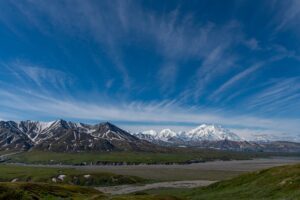Denali National Park and Preserve, historically known as Mount McKinley National Park, is an awe-inspiring landscape embedded in the heart of Interior Alaska. As an American national park and preserve, its territory extends around Denali, the highest mountain in North America. The park and contiguous preserve cover an expansive area of 6,045,153 acres, exceeding the total size of the state of New Hampshire. The establishment of the Denali Wilderness on December 2, 1980, further safeguarded an additional 2,146,580 acres within the park’s boundaries.
The natural diversity of Denali is nothing short of breathtaking. It combines a mix of forests at the lowest elevations, including deciduous taiga, with tundra in the middle and glaciers, snow, and bare rock at the highest peaks. The Kahiltna Glacier, recognized as the longest glacier within the park, adds to the icy allure of this captivating landscape. During winter, the park transforms into a playground for outdoor activities such as dog sledging, cross-country skiing, and snowmobiling.
Denali National Park has rightfully earned its reputation as Alaska’s most famous land attraction. Visitors from across the globe are drawn to its iconic sights, ranging from the towering Denali peak and the intricate networks of braided glacial rivers to the expansive tundra. The park is also a thriving habitat for diverse wildlife, offering the chance to spot moose, caribou, grizzly bears, Dall sheep, and wolves. With nearly 600,000 recreational visitors in 2018, Denali National Park is an unrivalled testament to Alaska’s untamed beauty.

Transport Options and Sheep Shuttle Service
Reaching Denali National Park and Preserve can be as much a part of the adventure as exploring the park. Located between Fairbanks, 120 miles to the north, and Anchorage, 240 miles to the south, the park is accessible by car, train, or bus, each offering a unique journey through the spectacular Alaskan landscape.
Driving is an excellent option for those who prefer the flexibility of setting their own pace. The park’s entrance can be found at Mile 237 of the George Parks Highway, a route that passes through many sights and charming towns, allowing travellers to soak in the Alaskan aura at their leisure.
Alternatively, the Alaska Railroad offers a relaxed and scenic ride from any stop along the rail belt, delivering passengers directly to the park entrance. This option allows travellers to sit back, relax, and immerse themselves in the picturesque landscape without the distraction of driving.
Finally, private bus tour operators offer convenient services from Anchorage and Fairbanks for those who prefer guided tours or lack personal transportation. Nearby communities such as Healy, Cantwell, Nenana, and Talkeetna also provide a range of lodging, tours, and other services, ensuring a comfortable journey to the magnificent Denali National Park.
Discovering Denali: Optimal Times and Ways to Immerse in Nature
The ideal time to dive into the awe-inspiring beauty of Denali National Park falls between mid-May and mid-September. During this period, visitors can take full advantage of the park’s amenities, bask in the joys of wildlife viewing, and participate in outdoor activities like hiking and camping. However, don’t discount the unique charm of a winter visit. Prepared adventurers can relish unique experiences like cross-country skiing and snowshoeing amidst long nights graced by the northern lights, thanks to minimal light pollution.
Yet, to truly embrace the wilderness of Denali National Park, one must venture beyond a single day’s exploration. The park’s vast expanse and diverse attractions call for an extended stay, allowing explorers to appreciate its natural marvels fully. A two-night stay near the park entrance or within the camping grounds is a good start, allowing ample time for various outdoor activities and an appreciation of Denali’s breathtaking vistas.
The allure of Denali’s wilderness goes even deeper for the most intrepid adventurers. A vacation in Kantishna, a region tucked deep within the park’s expanse, can be an enriching experience. Serving as a gateway to Denali’s untouched splendours, an extended stay of three to four nights in Kantishna offers a comprehensive exploration of this secluded oasis. Regardless of the duration, any time spent in Denali transcends a traditional vacation. Instead, it becomes an intimate journey into Alaska’s wild frontier, an encounter with unspoiled nature that follows its unhurried rhythm. This guide aims to facilitate your planning process and ensure a memorable and transformative experience within the borders of Denali National Park.
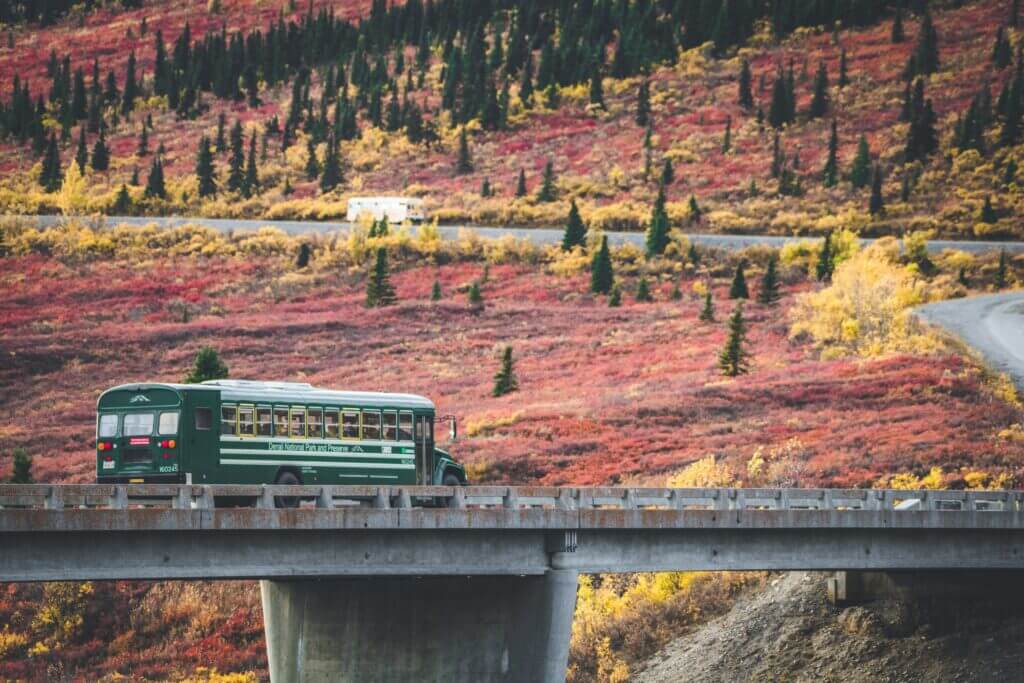
Adventures and Exploration in Denali National Park
Visitor Centers and Ecological Insights
Denali National Park has notable visitor centres. These centres are vital for understanding the park’s distinct ecosystem. The Denali Visitor Center and the Murie Science and Learning Center stand out. They’re positioned right at the park’s entrance. These centres are the main sources for guests who want to explore the park’s splendours.
The Denali Visitor Center is large and spread over 14,000 square feet. It is filled with engaging exhibits. Moreover, it has expert rangers. They are prepared to inform visitors about the park’s subtleties. The centre’s lower level is significant. It displays the area’s extensive natural and human history. Additionally, it houses a theatre. This theatre plays a film. This film unveils the mesmerizing wildlife and landscapes of the park. The upper level features something interesting. There is a giant tabletop relief map here. It visually represents Denali’s extensive and rough terrain. This map gives visitors a real feel for the park’s vastness.
Complementing this is the Murie Science and Learning Center, which provides intriguing hands-on exhibits and information about current research conducted in the park. The centre hosts nature-themed programs throughout the summer, encouraging visitors to interact with and learn from the natural environment. Furthermore, it serves as the primary visitor centre from October to April. The Eielson Visitor Centre lies deep within the park, at Mile 66 of Park Road. This impressive 7,400-square-foot interpretive centre displays exhibits on the region’s natural history and a detailed model of Denali. Large viewing windows offer guests unparalleled views of North America’s highest peak. However, reaching the Eielson Visitor Center requires participation in a park bus tour, adding another layer of adventure to the visit.
Bus Tours for a Journey into the Wild
Denali National Park offers visitors a unique opportunity to explore its heart via Denali Bus Tours. As private vehicles are limited on most of the 92-mile Park Road, bus tours are the preferred mode of transportation to delve deep into the park’s beauty. The park provides two distinct bus services: narrated tour buses and non-narrated transit buses.
Narrated tour buses have onboard naturalists. They tell stories about the park’s natural history. They drive passengers to popular sightseeing locations. These tours are a great way to explore the park in a structured manner. They stop for wildlife viewing. There are options for half-day or full-day tours. It depends on how far travellers want to go. Visitors are advised to reserve these bus tours in advance. They should check the Denali National Park website. It has the latest visitor information.
On the other hand, transit buses provide a more independent and economical option for visitors, especially appealing to campers and hikers. These hop-on, hop-off services offer the freedom to disembark at any point along Park Road, allowing for spontaneous exploration. At the end of their venture, hikers can flag down any bus to return to the park entrance. Additionally, free bus services operate a circuit from the park entrance to Savage River at mile 15 of the Park Road, adding to the myriad ways visitors can experience the majesty of Denali National Park.
Wildlife Wonders
Denali National Park’s charm extends beyond its towering peak, providing a sanctuary for Alaska’s “Big Five” wildlife – bears, moose, caribou, wolves, and Dall sheep. Within the park, you can observe all these majestic creatures. They add to the rich tapestry of the Alaskan wilderness. People often spot Grizzly bears traversing the open tundra. Meanwhile, black bears tend to favour the park’s forested areas. For those with a keen eye, a glimpse of the elusive wolves might be possible, though sightings vary based on the shifting locations of their dens. Regular sightings of moose, caribou, and Dall sheep add a common thread of wilderness engagement for visitors. The park also hosts many other mammalian species, such as lynx, marmots, Arctic ground squirrels, foxes, and snowshoe hares, alongside a vibrant avian population of 130 bird species.
The allure of Denali’s wildlife is that it caters to all visitors, not just those donning a backpack for a deep dive into the wilderness. Each visitor to the park is given an excellent chance to witness these extraordinary creatures thriving in their natural habitat, in all their untamed glory.
Moreover, the narrated bus tours are a prime choice for those keen on maximizing their wildlife viewing experience. The tour’s naturalist guides possess an expert eye for spotting wildlife, pausing the journey for ample time to appreciate and photograph the park’s inhabitants. These wildlife viewing stops are informational and provide an enriching experience, adding a dimension of wonder and excitement to the Denali adventure.
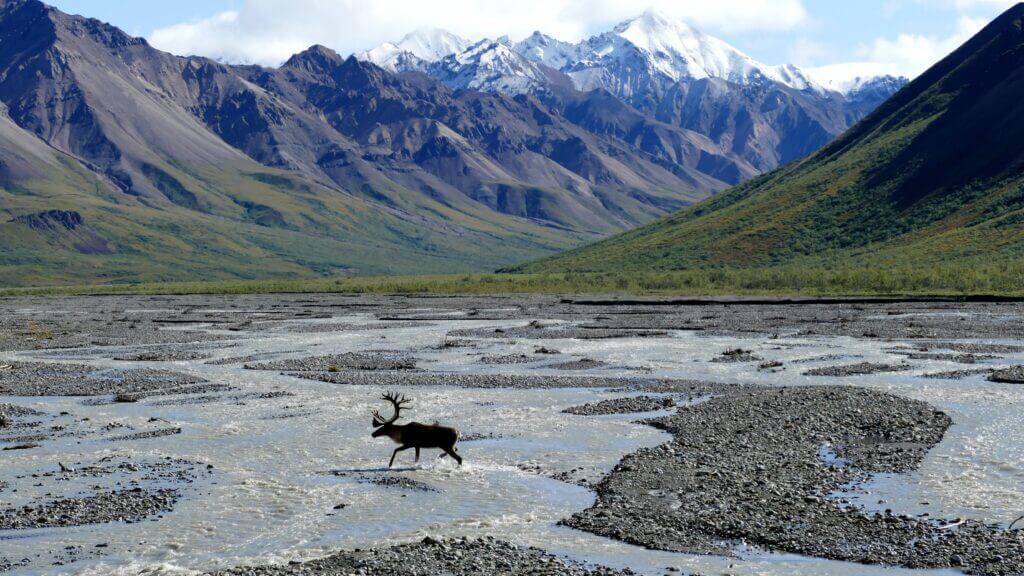
Diverse Trails and Backcountry Adventures
Denali National Park’s hiking and backpacking opportunities offer varied experiences for adventure-seekers. Near the park entrance lie eight trails, including the popular Horseshoe Lake Trail and Mt. Healy Overlook Trail. The Savage River Area offers the scenic Savage River Trail and the challenging Savage Alpine Trail. Additional trails are found near Eielson Visitor Center and Wonder Lake.
For a more immersive experience, Denali’s backcountry awaits. Despite few designated trails, vast landscapes of gravel riverbeds and tundra ridges are accessible. Backpackers can explore their private wilderness slice, given Denali’s permit system. The park divides into 87 units; each allocated a certain number of daily permits to prevent overuse. Free backcountry permits are available for overnight trips, obtained a day before the excursion. Park rangers guide visitors through this process, ensuring a rewarding and responsible adventure.
Denali Park Road Cycling
The Denali Park Road extends a thrilling invitation to cyclists desiring a day trip or an overnight bike-packing adventure in the heart of Denali National Park. The ride is challenging and calls for diligent planning and safety precautions, but the payoff lies in the awe-inspiring vistas and unprecedented access to Denali’s wild terrain. It’s important to note that Park Road is unpaved, lacks shoulders, and must be shared with park buses and other vehicles. As a result, cyclists must always stay alert and yield to other vehicles when necessary.
In the midst of this thrilling journey, it is common to encounter bears and other wildlife. Cyclists must respect these wild inhabitants and adhere to bear safety guidelines. Cyclists can transport their bikes on transit buses deeper into the park to expand their exploration. It’s advisable to make advanced reservations to secure bike space on these buses, allowing cyclists to further immerse themselves in the captivating allure of Denali National Park.
Savage River Trails and Park Road Lottery
Denali National Park extends a unique opportunity for visitors to drive their vehicles a considerable distance into the park. For the initial 15 miles, visitors can drive up to Savage River, offering easy access to various trails. From this point, two popular choices emerge the Savage River Loop, a flat, 2-mile journey along the river, and the more challenging Savage Alpine Trail, a 4-mile climb that rewards expansive views from a high ridge. However, the Savage River parking lot can quickly reach capacity.
Alternatively, a free shuttle is available from the park entrance to Savage River, ensuring convenient access even during peak times. The annual Denali Park Road Lottery is a special feature of the park’s vehicle access policy. This event allows selected visitors to drive their private vehicles across the entire Park Road on certain days in September, allowing for a fully immersive exploration of Denali’s vast, rugged landscape.
Denali Sled Dog Rangers
Denali National Park proudly hosts the only sled dog team in the United States that actively patrols a national park. These dedicated canine rangers reside in the park’s sled dog kennels, open to visitors all year round. Located near the park entrance, visitors can meet these remarkable dogs and witness demonstrations highlighting their exceptional role and rich history. These experiences offer a unique insight into the crucial contributions these canine rangers make to the park, making a visit to the Denali Sled Dog Kennels a must-see for any Denali itinerary.
Denali Flightseeing Tours
Experience the grandeur of Denali, North America’s highest peak, without the gruelling climb, through an exhilarating flightseeing tour. Offering breathtaking aerial views of the park, these tours even provide the opportunity for glacier landings. Departing from either the park entrance or the delightful mountaineering hub of Talkeetna, flightseeing tours present a fantastic and time-efficient alternative to traditional Park Road bus tours. A flightseeing tour is a truly unique way to witness the dramatic beauty of Denali and its surroundings, offering a perspective on the park that few get to see.
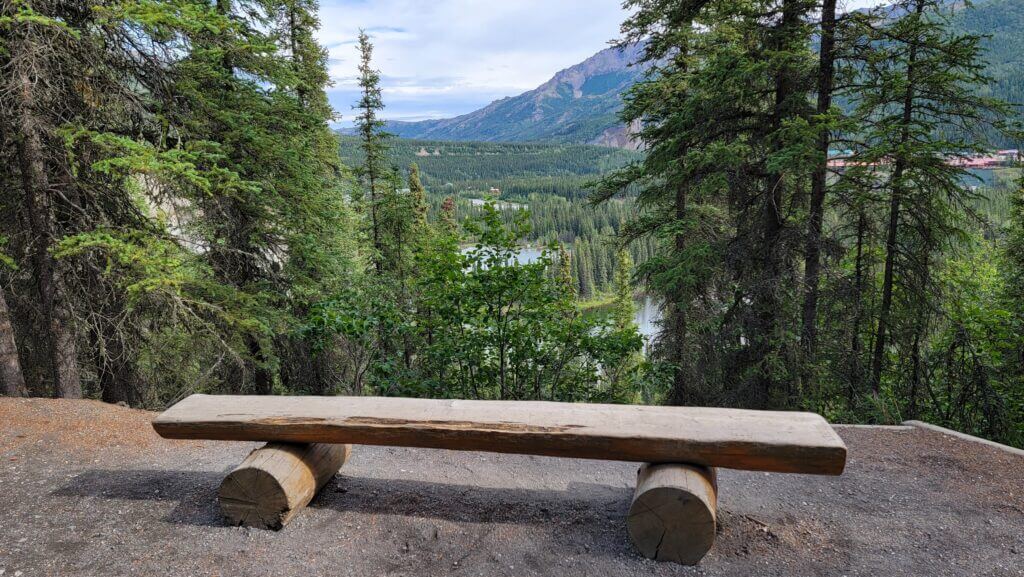
History
Pre-history and Proto-history
Delving into the historical tapestry of Denali National Park reveals a rich prehistory and protohistory, marked by human habitation extending over 11,000 years. Documented sites beyond the park boundaries provide archaeological evidence dating back over 8,000 years. The archaeological imprint within the park’s borders is somewhat scantier due to the region’s high elevation, harsh winters, and relatively scarce resources.
The oldest confirmed site within the park is the Teklanika River site, dating back to around 7130 BC. Over 84 archaeological sites across the park suggest the region served as hunting grounds rather than permanent settlements, providing limited cultural context. Linguistic and archaeological evidence dates the presence of Athabaskan peoples in the region to 1,500 to 1,000 years ago. Still, it’s speculated that Athabaskans may have inhabited the area for millennia before then.
The Koyukon, Tanana, and Dena’ina people have frequented the park’s landscapes in recent centuries. Their rich cultural legacies contribute to the diverse historical heritage of Denali National Park, painting a vivid picture of human interaction with this rugged and beautiful wilderness.
A Century of Conservation and Progress
The creation of Denali National Park was an important event in conservation history. The idea came from Charles Alexander Sheldon in 1906. He wanted to preserve the Denali region as a national park. Approval and cooperation were needed from various places. This included Alaska’s delegate to Congress, James Wickersham. A bill was introduced in 1916. There was a lot of lobbying for the bill. It finally passed on February 19, 1917. President Woodrow Wilson signed it into law on February 26, 1917. This led to the creation of Mount McKinley National Park. The park’s boundary initially didn’t include Denali’s summit. However, the boundary expanded in later years.
Key milestones in the park’s development included the opening of the Mount McKinley Park Hotel in 1921, a notable stop for President Warren Harding in 1923 during his tour of the Alaska Railroad. Despite its initial allure, reports of subpar conditions led to the hotel’s closure and eventual destruction in 1972. In 1938, after 17 years of construction, the 93-mile Park Road was completed, and access to the park entrance was established in 1957 with the opening of the Denali Highway. This led to an exponential increase in park attendance, from 5,000 visitors in 1956 to 25,000 by 1958.
While the park has witnessed significant events, such as the Mount McKinley disaster in 1967, it has continued to evolve and expand. Designated as an international biosphere reserve in 1976, it was combined with the surrounding Denali National Monument, proclaimed by President Jimmy Carter in 1978, to form the present Denali National Park in 1980.
Naming Dispute
The naming of what is now known as Denali National Park has a contentious history. Initially called Mount McKinley National Park, the park faced local disapproval due to its departure from indigenous nomenclature. In the Athabaskan language, “Denali” means “the high one”, a reference to the majestic mountain at the park’s core. In 1897, William A. Dickey, a local prospector, named the hill after the recently elected U.S. President William McKinley. The U.S. government formally adopted the name Mount McKinley with the creation of the national park in 1917.
Over six decades later, in 1980, a significant change occurred. Mount McKinley National Park was merged with Denali National Monument under the Alaska National Interest Lands Conservation Act, forming the Denali National Park and Preserve. Subsequently, the Alaska State Board of Geographic Names renamed the mountain Denali, acknowledging its native Athabaskan roots. However, the U.S. Board of Geographic Names did not officially recognize this change and continued to use the Mount McKinley designation.
The dispute over the name persisted until August 30, 2015, when President Barack Obama instructed Secretary of the Interior Sally Jewell to rename the mountain Denali officially. This direction was based on statutory authority that allowed action on such requests when the Board of Geographic Names failed to do so within a “reasonable” period. Thus, the towering peak and the splendid park it dominates finally received federal recognition by its native name: Denali.
Magic Bus 142: A Poignant Legacy in Denali National Park
Denali National Park became the backdrop for a poignant tale in the 1990s when Christopher McCandless ventured into the vast Alaskan wilderness. In 1992, he settled in an abandoned bus, famously known as ”Magic Bus 142”, located on the Stampede Trail near Lake Wentitika. Carrying minimal food and equipment, McCandless sought a solitary life close to nature. His vacation, however, ended tragically, as he was discovered almost four months later, starved and weighing a mere 67 lb.
The story of McCandless grabbed public attention. It was shared widely through articles, books, and films. The bus where he spent his last days became a symbol. It stood for adventure and solitude for many people. Decades later, in September 2020, there was an announcement. The University of Alaska’s Museum of The North said that “Magic Bus 142” had a permanent home. Plans were revealed. They would restore the bus and create an outdoor exhibit. This would further embed McCandless’s legacy in the stories of Denali National Park.
Milestones of Recognition and Development
In the 2000s, Denali National Park witnessed significant moments of recognition and development. The park was celebrated nationally on November 5, 2012, when the United States Mint released a quarter as part of its America the Beautiful series, honouring Denali National Park. The coin’s reverse side elegantly showcases a Dall sheep against the majestic backdrop of Denali, encapsulating the park’s rich wildlife and breathtaking scenery.
A year later, in September 2013, President Barack Obama enacted the Denali National Park Improvement Act. This law expanded the park’s capabilities for renewable energy and development, allowing the Department of the Interior to issue permits for micro-hydroelectric projects in the Kantishna Hills area, exchange land with Doyon Tourism, Inc., and authorize the National Park Service to permit the construction of a natural gas pipeline within the park. Additionally, it paid tribute to local heritage by renaming the Talkeetna Ranger Station as the Walter Harper Talkeetna Ranger Station. This legislation, well-received by the National Parks Conservation Association, marked a thoughtful balance between conservation, renewable energy development, and honouring native Alaskans.
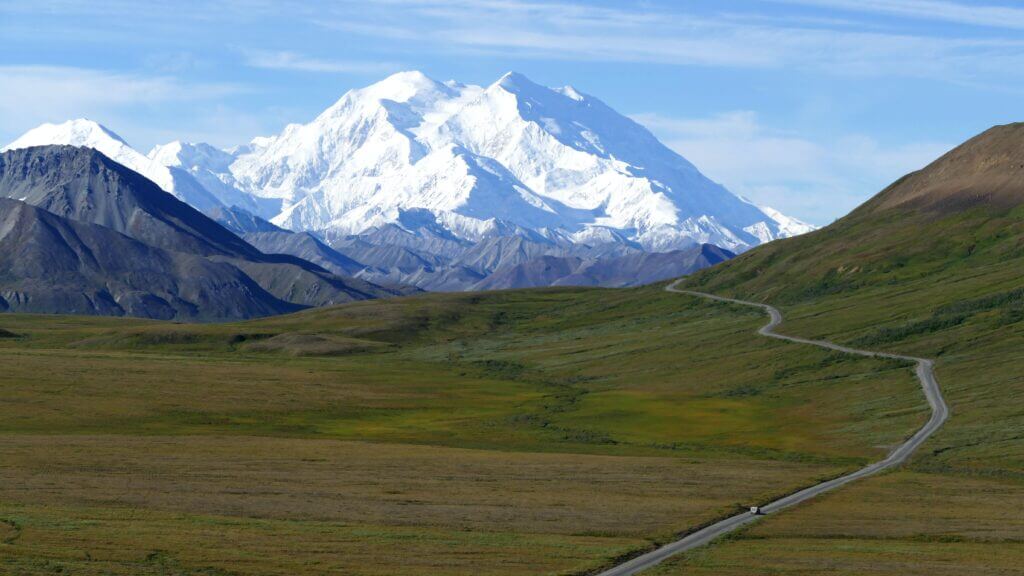
Embracing the Heart of the Alaska Range
Denali National Park and Preserve cover most of the Alaska Range’s core. It includes numerous glaciers and glacial valleys. These flow southwards from the range. To the north, the park includes fertile valleys. These are the valleys of the McKinley, Toklat, and Foraker Rivers. It also includes the Kantishna and Wyoming Hills. The George Parks Highway is on the eastern edge of the park. It crosses the Alaska Range. This marks a division between the valleys of the Chultina and Nenana Rivers.
Just about 11 miles south of Healy, the park’s entrance unfolds. The Denali Visitor Center and park headquarters lie within its threshold, serving as the gateway to a world of wilderness. A 92-mile road, closely mirroring the path of the Alaska Range, navigates through the park, concluding its journey at Kantishna.
Preserve lands are on the park’s west side. They have a contrasting use of ethos. One part of the preserve lands has the areas of Highpower Creek and Muddy River. These areas are full of lakes. The other preserve region protects the southwestern end of the Alaska Range. This includes Mount Dall. The park has restrictions on hunting. However, the preserved lands allow sport hunting. Nikolai, Telida, Lake Minchumina, and Cantwell residents can hunt in the park. This honours their historic hunting traditions in the area.
Vehicle Access and Embracing the Wilderness
Journeying into Denali National Park takes you along the Denali Park Road, a 92-mile stretch from George Parks Highway to Kantishna. This road hosts critical facilities, like the Denali Bus Depot and the Denali Visitor Center, near its outset. Private vehicles can access the first 15 miles until the Savage River Bridge; access is limited to tour and shuttle buses.
The grave road, designed to navigate permafrost challenges, cuts through the heart of the majestic Alaska Range. It provides spectacular views of boreal forests and tundra landscapes, with significant stops, including the Toklat River Contact Station and the Eielson Visitor Center. However, the road has been impacted by the Pretty Rocks landslide at Polychrome Pass, limiting access beyond Mile 45 since August 2021. A significant restoration project involving a $55 million bridge is underway to restore full road access.
Access to the park’s interior campgrounds is only available via camper buses, while Kantishna lodges can be reached by bus or air taxi. The surrounding areas of McKinley Park and Denali Park offer ample services. Meanwhile, the park’s preserve and non-wilderness areas provide limited dirt road access. Climbers wishing to challenge the peaks will need a Walter Harper Talkeetna Ranger Station permit, and hikers can choose between maintained trails and off-trail hikes.
However, the journey to Denali is not just about the road. The Denali Wilderness forms a significant part of the park, safeguarding the towering peaks of the central Alaska Range, including the park’s namesake, Denali. This wilderness, which comprises one-third of the park, mirrors the original park boundaries pre-1980. It preserves the unspoiled splendour of Alaska’s high country, offering visitors a raw, captivating, and genuine wilderness experience that truly embodies the Alaskan spirit.
Permafrost: Denali’s Ice-Bound Bedrock
Denali National Park’s icy landscape is intertwined with permafrost, a layer of constantly frozen ground beneath the Alaskan wilderness. Vegetation, temperature, snow cover, and water flow influence this layer’s continuity. The active layer above it, which freezes and thaws each season, varies in thickness from one inch to ten feet. This layer sits on the permafrost, located 30 to 100 feet below the surface.
Permafrost uniquely shapes Denali’s landscape. The oddly angled white spruce in the “Drunken Forest” on Denali’s lower slope results from soil shifting due to freeze-thaw cycles. This permafrost impacts more than just the landscape; it influences the park’s hydrology, vegetation, and wildlife habitats.
Denali was entirely enshrouded in permafrost in the Pleistocene era’s icy clutches. Persistent cold still keeps the range’s northern areas frozen. However, Denali’s permafrost has been on a steady retreat since the 1950s, when 75% of the park held near-surface permafrost. By the 2000s, this figure dwindled to 50%, and predictions suggest that only 6% might persist by the 2050s. This decline is attributed to climate change causing most of the shallow permafrost to thaw, threatening a rise in atmospheric carbon and a spate of landslides as ice-rich soil liquefies into a muddy slurry.
The permafrost‘s thaw paints a curious picture of Denali’s surface. Shallow ponds dot the landscape, known as cave-in lakes. These basins are formed when sun-warmed water gradually gnaws at the underlying permafrost, their rims collapsing, and the lakes growing in size during warm summers.
Permafrost is peculiar for its tendency to expand and contract with temperature changes, causing cracks. Summer waters fill these cracks, forming ice wedges. Seasonal freeze-thaw cycles gradually expand these wedges. Excavations or landslides can uncover some buried for centuries, showing Denali’s permafrost world’s dynamic and delicate balance.
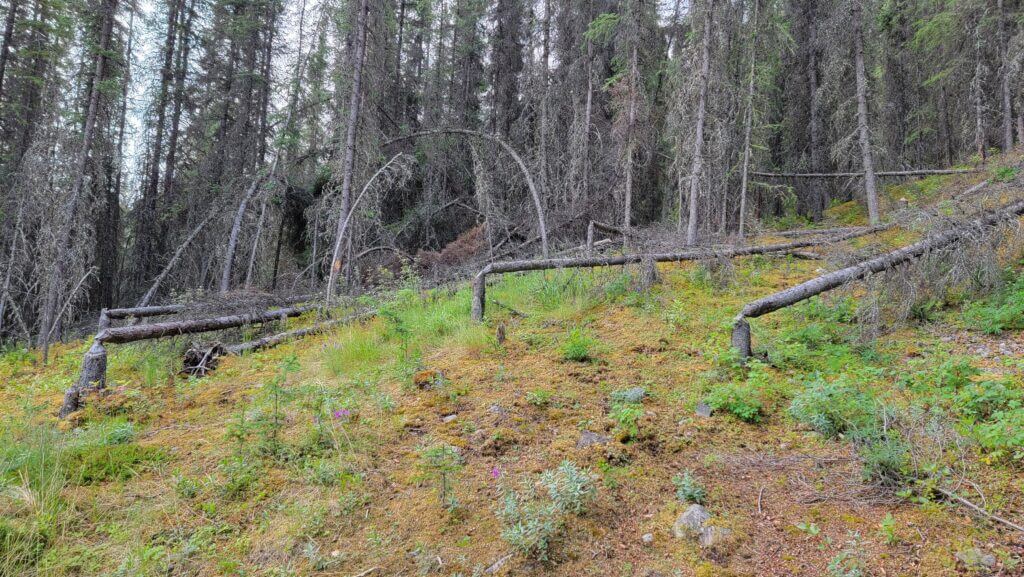
Glaciers: Denali National Park’s Frozen Rivers
Veiling 16% of Denali National Park’s six million acres, glaciers are a breathtaking facet of the park’s landscape. These icy behemoths lose around 6.6 ft of vertical water equivalency every year, subtly reshaping the park’s topography. Interestingly, the park’s southeastern side harbours more extensive glaciers, nourished by moisture-laden winds from the Gulf of Alaska. Here lie the park’s colossal south-facing glaciers – Yentna, Kahiltna, Tokositna, Ruth, and Eldridge – with the Ruth glacier reaching a thickness of 3,800 ft.
On the park’s northern side, you’ll find the largest glacier – the 32-mile-long Muldrow Glacier. This glacier has surged twice in the past century, momentarily accelerating its pace due to water buildup beneath its icy mantle.
Denali’s glaciers etch the park’s geological architecture, carving out semicircular basins known as cirques at their upper ends. Over time, the continual erosion of these cirques on opposite sides of a ridge forms serrated ridges called arêtes and low points known as cols, shaping the characteristic landscape of the park. These glaciers also transport rock debris, depositing it through erratics, lateral, and medial moraines.
Denali’s glaciers flow from high altitudes. They start from as high as 19,000 feet and go down to 800 feet. These glaciers fill the park’s rivers with icy meltwater. This meltwater is turbulent and filled with sediment. It contributes to the formation of various landscape features. These include braided meltwater streams, valley trains, and kettle lakes. This enhances the park’s diverse landscape.
The glaciers are crucial in shaping Denali’s landscape. They’re like the icy arteries of the park. They flow away from the mountains and drain snow and ice from Mt. McKinley’s sides. The size of these glaciers is impressive. Their dynamics are also complex. This greatly affects the park’s natural features. It shows the raw power of nature and its never-ending transformation.

